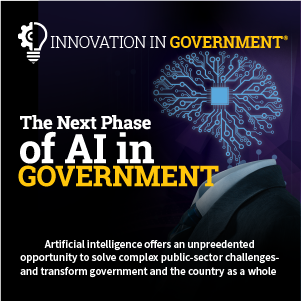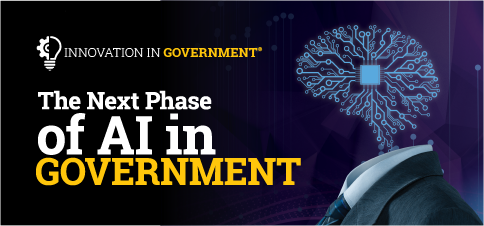For government, artificial intelligence (AI) promises to streamline operations, facilitate decision-making and improve customer services in ways that weren’t possible before. Agencies have already begun using machine learning, robotic process automation, the internet of things and other AI tools to improve operations, but in many ways, AI’s potential is still untapped. In a recent survey of FCW readers, 72% said their agencies have not begun deploying AI-based tools, and 70% said their teams had no training in data science or AI. Learn the latest insights from industry thought leaders in artificial intelligence in Carahsoft’s Innovation in Government® report.
 AI in 2020: Just Get Started
AI in 2020: Just Get Started
“Gartner predicts that by next year, 70 percent of organizations will boost their employees’ productivity by integrating AI in the workplace. But what does this mean for the public sector? Federal agencies need to move quickly to harness this game-changing technology. Some have already started — we’re seeing AI automate drug intake forms at the FDA, verify IT credentials at the Defense Department and automate financial transfers at the Treasury Department. With the federal government being one of the largest collectors of data, AI has great potential for every agency.”
Read more insights from NVIDIA’s Vice President of Public Sector, Anthony Robbins.
The Perfect Storm Behind the Rise of AI
“The ideas behind AI are not new. However, three elements have come together to create a perfect storm and push AI to the forefront. First, our ability to capture more digital data has grown exponentially. Although we’ve understood some basic ideas about machine learning and deep learning for decades, it’s only been in the last decade that we’ve had enough data to use those techniques in interesting enterprise, research and government applications. Second, the advent of powerful processors and the adoption of graphics processing units make it possible to perform a tremendous number of computations on a vast amount of data. Along the way, the algorithms used for those computations have matured, adding the third element to the perfect storm for AI adoption.”
Read more insights from Dell Technologies’ AI and HPC Technology Specialist, Jay Boisseau.
Transparency’s Role in AI Innovation
“Predictive analytics, machine learning and AI in general aren’t intended to replace people. Instead, they augment human activity so we can make better decisions and do more meaningful work. For example, business process automation can facilitate closer collaboration between the IT and business teams to ensure better outcomes. Business teams may never have needed to articulate their processes before, but business process automation requires it. This articulation leads to ‘aha’” moments where improvements can be identified. Teams may also uncover opportunities to minimize choke points and single points of failure where only a few individuals know the details involved.”
Read more insights from Red Hat’s Chief Technologist of North America Public Sector, David Egts.
The Power of An Open-Source Approach to AI
“Incorporating new technology like AI requires some level of IT modernization for most agencies. Security and governance are key attributes of any modernization effort, but the ability to integrate new solutions into existing systems is also essential. Unfortunately, many of the government’s legacy systems struggle to keep up with growing demands for storing and accessing the unstructured data that fuels AI applications. I recently developed a forecast for top technology trends in 2020, and a key prediction is that open-source software and approaches will become increasingly important for supporting all the data center traffic that is shifting to the cloud.”
Read more insights from Cloudera Government Solutions President Shaun Bierweiler.
Cloud Raises AI to New Heights
“AI raises many questions about the ethics involved in applying the technology to areas as diverse as battlefields and hospitals, as well as addressing inherent challenges related to bias in datasets. We should establish guardrails to ensure that AI platforms are providing good outputs and being fully transparent. And we should know how an AI tool reached its conclusion and how the data was collected, among other things. For data sharing to work under the Federal Data Strategy, we must have a common data model and bilateral agreements.”
Read more insights from Microsoft’s CTO, Susie Adams.
Modernizing Intelligence Analysis
“Government agencies have access to more sensors and more data sources than ever before, but they need appropriate automation technology to make timely decisions. Artificial intelligence and the subfield of machine learning provide mechanisms for decision-makers to get more value out of their information by enabling faster analysis of more data. Most federal agencies have too much data to analyze manually. Take the U.S. Geological Survey, for example. USGS works with NASA to distribute data from Landsat satellites and provide remote sensing photographs of the Earth. Millions of photos have been collected since 1972 — far too many for any organization to manually analyze every photo for information about how the world is changing.”
Read more insights from Black Cape’s Co-CEOs, Abe Usher and Al Di Leonardo.
Building Public Trust in Responsible AI
“As the use of artificial intelligence grows, we need to maintain vigilance so the technology properly integrates safety principles to help us manage and secure our data and models — and ensure the public’s trust in applications of AI. It starts with secure, unbiased datasets. Algorithms and other foundational datasets must get monitored during training and inference to counter attack vectors such as corruption and data. Taking such steps also strengthens compliance with legal requirements such as Europe’s General Data Protection Regulation, which imposes various limitations on data usage.”
Read more insights from Lockheed Martin’s Principal AI Strategist, Chris Benson, and Chief Data and Analytics Officer, Matt Tarascio.
The Importance of Adding Context to Data
“Artificial intelligence is the key to finding relevant information in a sea of data as a source of value creation and delivery to gain a competitive advantage. AI can offer invaluable insights into public sentiment, help agencies resolve security-related IT events and support a comprehensive approach to critical infrastructure protection. By leveraging advanced correlation and aggregation techniques, agencies can use AI to eliminate redundant or non-important information and thereby improve mission outcomes. For example, Micro Focus Government Solutions feeds our advanced security information and event management system with data from log file collectors to greatly reduce irrelevant data, improve cyber hunting and detection, and fuel predictive analytics.”
Read more insights from Micro Focus Government Solutions’ CTO, David Wray.
Democratizing Data Science
“Across the public sector, the amount of data that agencies collect continues to grow exponentially. The question is: How do we channel the information that comes from all this data toward the most effective outcomes? Artificial intelligence allows the government to harness the power that’s already available in various datasets to make more informed and more accurate decisions on behalf of citizens. AI does that by giving agency subject-matter experts the ability to quickly solve complex problems without relying on manpower in the form of dedicated data science teams. Ideally, agency employees should be able to take advantage of AI without having to get a Ph.D. in data science. That’s where automated machine learning can help.”
Read more insights from DataRobot’s General Manager of Federal, Chad Cisco.
A New Approach to Data Analytics
“Across the public sector, the amount of data that agencies collect continues to grow exponentially. The question is: How do we channel the information that comes from all this data toward the most effective outcomes? Artificial intelligence allows the government to harness the power that’s already available in various datasets to make more informed and more accurate decisions on behalf of citizens. AI does that by giving agency subject-matter experts the ability to quickly solve complex problems without relying on manpower in the form of dedicated data science teams. Ideally, agency employees should be able to take advantage of AI without having to get a Ph.D. in data science. That’s where automated machine learning can help.
Read more insights from ThoughtSpot’s Vice President of Public Sector, Monica McEwen.
Executive Viewpoint: A Conversation with Ken Thomson
“To shift this power equation in favor of the government, HHS is using AI to centralize its contract information into a single data layer, converting contract and attachment data into metadata (plain text), structuring it by category and sub-categories, and building a universal taxonomy for how to understand the information in a common way. The AI identifies where we are buying “like-to-like” goods and services across our divisions utilizing data algorithms derived from the variables developed by HHS contracting and mission subject-matter experts (SMEs).”
Read more insights from this Q&A with the Department of Health and Human Services’ BuySmarter Solution Architect, Ken Thomson.
Download the full Innovation in Government® report for more insights from these government AI thought leaders and additional industry research from FCW.







